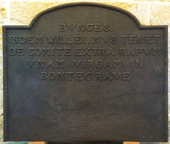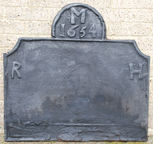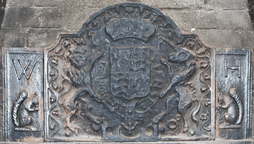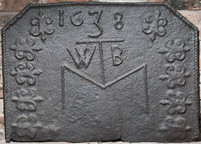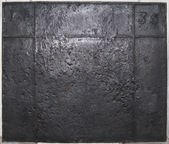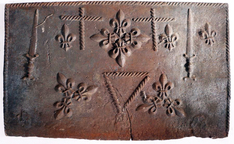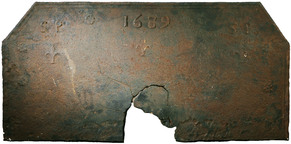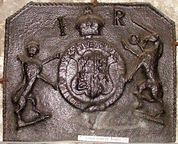-
1205
Description: Arched rectangular shape; cavetto moulded edging; top centre within arch, initials above date.
Notes: Plain elegant fireback from a late series, probably cast in the south east of England. The crack emanating from the top right corner of the fireback seems to be a weakness on all the recorded examples, and may have caused by thinness of the base board at that point.
Inscription: R.R / 1857
- Decoration tags:
- rectangular with round arch (shape)
- cavetto (edging)
- carved stamps
- individual letters
- individual numbers
- text
Manufactured: in 1857 in England.
Current location: in private hands, Horsted Keynes, West Sussex, England.
- Attached to series:
- 1850s series
-
1206
Description: Arched rectangular shape; twisted rope edging (top and sides); top, centred, text in five lines uppercase with the letter 'U' represented as 'V'.
Notes: Apart from the word 'Bunces' the text is an expanded transcription of the entry in the Domesday Book for Birch Grove, south of East Grinstead. Allegedly it was the author, Rudyard Kipling, who suggested to the then owner of that property that the text be used to decorate a fireback.
Inscription: BVNCES. / ISDEM WILLELMVS TENET / DE COMITE EXTRA RAPVM / VNAM VIRGAM IN / BONTEGRAVE
- Decoration tags:
- rectangular with round arch (shape)
- rope (edging)
- whole carved pattern
- text
Manufactured: in the early-20th century in England.
Current location: in private hands, Horsted Keynes, West Sussex, England.
- Attached to series:
- Commemorative firebacks
-
878
Description: Cavetto-canted arched rectangle; twisted rope edging, separately around rectangle and arch; initials 'R' and 'H' in upper left and right corners of rectangle; 'M' above date in arch.
Notes: The arch does not appear to have been a separate stamp, although the rope edging gives that impression; the initials, in triad, suggest a husband and wife - R.. and H.. M..
Inscription: M / 1654 / / R H
- Decoration tags:
- rectangular with canted top corners and round arch (shape)
- rope (edging)
- simple stamps
- carved stamps
- individual letters
- individual numbers
- text
Manufactured: in 1654 possibly in the Weald area of England.
Current location: in private hands, Birling, Kent, England.
- Attached to series:
- Date & initials firebacks
-
1244
Description: Cavetto-canted arched rectangular shape with rectangular extension panels; cavetto-moulded edging, with astragal on wide fillet edging on the extension panels; central panel, crown, shield and Garter of the Tudor royal arms but with crowned lion and unicorn supporters, all within an undulating vine border; extension panels comprise a single letter (W on left, H on right) above an inward-facing seated squirrel.
Notes: The royal arms are a hybrid of the Tudor and Stuart achievement, quite crudely modelled. The initials and squirrels both relate to the Holte family who lived at Aston Hall, which was built between 1618 and 1623. The difference in the condition of the armorial and the extensions suggest that the armorial was significantly older than the extensions. The bottom 190mm of the fireback is concealed below, behind the grate placed in front of it.
Inscription: W / HONY SOIT QUI MAL Y PENSE / H
Arms: English Tudor royal with Stuart lion and unicorn supporters
- Decoration tags:
- rectangular with canted top corners and round arch (shape)
- cavetto (edging)
- carved stamps
- carved pattern panels
- extension panels
- heraldic
- armorial
- royal
- text
- animals
Manufactured: in the mid- to late-17th century in England.
Current location: Aston Hall, Aston, West Midlands, England.
(part of the Birmingham Museums Trust museum group)
- Attached to series:
- Stuart royal armorial firebacks
-
1242
Description: Canted rectangular shape; twisted rope edging (top and sides); top centre, date, 1638, with uneven figures (oversize 3), between two fleurs-de-lys; four fleurs-de-lys, lying horizontally, down each side; below date, slender 'T' shape above a slender 'M' shape, with initials 'W' and 'B' separated by the 'T' shape.
Notes: The distinctive fleur-de-lys has not been noted on any other fireback. Purchased by Birmingham Museums in 1982 at the sale of the contents of the house ‘Hildercroft’ on Highfield Road in Hall Green, Birmingham.
Inscription: 1638 / W T B / M
- Decoration tags:
- rectangular with canted top corners (shape)
- rope (edging)
- simple stamps
- carved stamps
- heraldic
- text
- objects
Manufactured: in 1638 in England.
Current location: Blakesley Hall, Blakesley Road, Yardley, West Midlands, England.
(part of the Birmingham Museums Trust museum group)
- Attached to series:
- Miscellaneous stamp firebacks
- Fleur-de-lys firebacks
-
203
Description: Rectangular; fillet edging; fillet parallel to top edge separating top quarter; two fillets parallel to sides separating side quarters; halves of date in top corner squares.
Notes: Numeral style is typical of first half of 18th century.
Inscription: 17 36
- Decoration tags:
- rectangular (shape)
- fillet (edging)
- individual numbers
- text
Manufactured: in 1736 in England.
Current location: Selly Manor, Birmingham, West Midlands, England.
(part of the Selly Manor museum group)
- Attached to series:
- Date only firebacks
-
1219
Description: Rectangular shape; twisted rope edging (top and sides); top centre, cross-shaped arrangement of four fleurs-de-lys between to crosses formed of lengths of twisted rope with single fleurs outside and beyond each of them a dagger, point upwards; to the right, a single fleur; bottom centre, a triangle formed of three lengths of twisted rope, vertex to the bottom, between two non-identical groups of three fleurs arranged in star pattern.
Notes: The style of the fleurs-de-lys associates this fireback with a series with several examples. The dagger type (approximate length 32cm) is different to others in the same series. Bishop & Miller Auctioneers, Stowmarket, 27 Jan 2022, lot 88 (£110).
- Decoration tags:
- rectangular (shape)
- rope (edging)
- simple stamps
- carved stamps
- heraldic
- apotropaic
- objects
Manufactured: in the mid- to late-16th century in the Weald area of England.
Current location: not known.
- Attached to series:
- Royal series
- Knife & Dagger stamp firebacks
- Fleur-de-lys firebacks
-
1228
Description: Canted rectangular shape; double fillet edging (top and sides); top centre, date; initials, SP, repeated in top corners; a fleur-de-lys below each pair of initials and the date; between the initials and the date, a flower head, with two more flower heads arranged vertically on each side below the initials.
Notes: The style of the fleurs-de-lys, and the distinctive form of the number '8', indicate that this fireback is one of a small series. Bishop & Miller auction, Stowmarket, Suffolk, 25 May 2022, lot 292 & 23 Feb 2023 lot 250, and Auctionet 4 Aug 2023, lot 2960707.
Inscription: SP 1689 SP
- Decoration tags:
- rectangular with canted top corners (shape)
- double fillet (edging)
- carved stamps
- individual letters
- individual numbers
- heraldic
- text
- plants
Manufactured: in 1689 possibly in the Shropshire area of England.
Current location: not known.
- Attached to series:
- Ludlow series
-
204
Description: Canted rectangle; twisted rope edging (top and sides); Tudor royal shield and Garter with crown above, between lion and unicorn supporters; initials separated by crown; a small ring and bar are placed to the left of the unicorn’s mouth.
Notes: The Tudor shield and crown feature on many Wealden firebacks, and have here been reused with Jacobean supporters; their stamps are derived from standing models.
Inscription: I R
Arms: Tudor royal
- Decoration tags:
- rectangular with canted top corners (shape)
- rope (edging)
- carved stamps
- individual letters
- heraldic
- armorial
- royal
Manufactured: in the early-17th century possibly at Pounsley Furnace, Framfield in the Weald area of England.
Current location: St Mary's Abbey, Blanchland, Northumberland, England.
- Attached to series:
- Pounsley series
- Jacobean royal armorial firebacks
-
889
Description: Arched shape; fillet edging; swan within a voided strapwork cartouche; date in Arabic numerals, at bottom, on a broad horizontal fillet.
Notes: Stylistically, of the early 17th century, suggesting the date is 1617, although the third numeral is indistinct. Bonham's sale, Chester, 18 October 2012, lot 384 (£375).
Inscription: 16 1[?]7
- Decoration tags:
- rounded arched (shape)
- fillet (edging)
- whole carved pattern
- heraldic
- architectural
- text
- animals
Manufactured: in 1617 in England.
Current location: not known.
- Attached to series:
- Miscellaneous pattern firebacks

